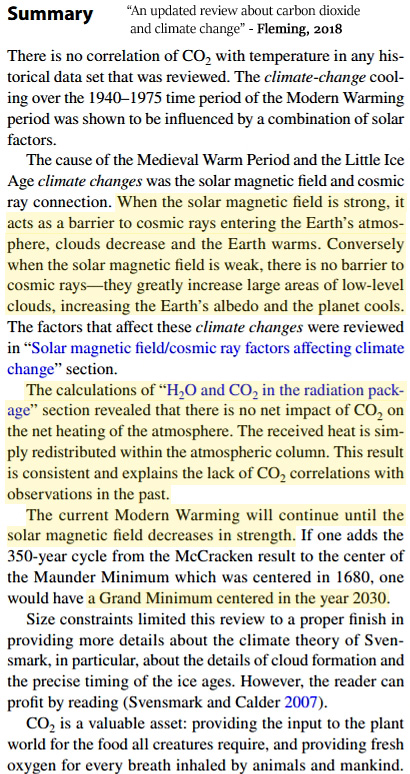
Image Source: American Meteorological Society
Solar Magnetic Field, Cosmic Rays/Clouds → Climate
CO2 Has A ‘Zero Net Effect’
Dr. Rex J. Fleming, a former NOAA climate scientist who earned both his Master’s and Ph.D in meteorology, has published a new paper in the Environmental Earth Sciences journal that details the lack of an identifiable causal relationship between CO2 concentration changes and Earth’s temperature changes. He suggests “there is no propensity for CO2 to store heat in a systematic way over time to produce a climate change effect”.
Dr. Fleming introduces an alternative “theory of climate change—due to the Sun’s magnetic field interacting with cosmic rays”. He theorizes that the Earth’s temperature has warmed in the modern era as a consequence of the strong solar activity during the 20th century (the Modern Maximum) shielding cosmic ray intensification and thus reducing decadal-scale cloud cover, which leads to warming via an increase in absorbed surface solar radiation (as illustrated here by Ogurtsov et al., 2012 and detailed by Avakyan, 2013, McLean, 2014, and others).
Dr. Fleming further proposes that the Earth may cool as it slides into a Solar Grand Minimum in the coming few decades (~2030) due to a predicted decline in the solar magnetic field and concomitant cloud cover increases seeded by cosmic ray intensification.
Key points from the paper are categorized below.
An Updated Review About Carbon
Dioxide and Climate Change
Fleming, 2018
Summary
“The results of this review point to the extreme value of CO2 to all life forms, but no role of CO2 in any significant change of the Earth’s climate. … There is no correlation of CO2 with temperature in any historical data set that was reviewed. The climate-change cooling over the 1940–1975 time period of the Modern Warming period was shown to be influenced by a combination of solar factors. The cause of the Medieval Warm Period and the Little Ice Age climate changes was the solar magnetic field and cosmic ray connection. When the solar magnetic field is strong, it acts as a barrier to cosmic rays entering the Earth’s atmosphere, clouds decrease and the Earth warms. Conversely when the solar magnetic field is weak, there is no barrier to cosmic rays—they greatly increase large areas of low-level clouds, increasing the Earth’s albedo and the planet cools. The factors that affect these climate changes were reviewed in “Solar magnetic field/cosmic ray factors affecting climate change” section. The calculations of “H2O and CO2 in the radiation package” section revealed that there is no net impact of CO2 on the net heating of the atmosphere. The received heat is simply redistributed within the atmospheric column. This result is consistent and explains the lack of CO2 correlations with observations in the past. The current Modern Warming will continue until the solar magnetic field decreases in strength. If one adds the 350-year cycle from the McCracken result to the center of the Maunder Minimum which was centered in 1680, one would have a Grand Minimum centered in the year 2030.”
It’s Not CO2
CO2 Changes Lag Temperature Changes
“Ice cores with sufficient vertical resolution (time resolution) have provided 420,000 years of data from Antarctica indicating that the temperature changes preceded the corresponding CO2 changes. An American team found the time lag (due to ocean mixing) of CO2 behind temperature of several hundred years. The oceanic reservoir of CO2 is far greater than that of the atmosphere. When the oceans are warm, they outgas CO2, and when the oceans are cold atmospheric CO2 dissolves into the oceans (Fisher et al. 1999).”
“A subsequent study in 2003 by a French team indicating that deglaciation was not caused by CO2 which lagged the temperature by 200–800 years (Caillon et al. 2003). A third efort by Russian scientists arrived at the same conclusion, where the estimated delay was 500–600 years (Monin and Sonechkin 2005). This was claimed to be 420,000 years of data with indisputable evidence that CO2 concentrations of the atmosphere are the effect of global temperature changes and not their cause (Chilingar et al. 2008).”
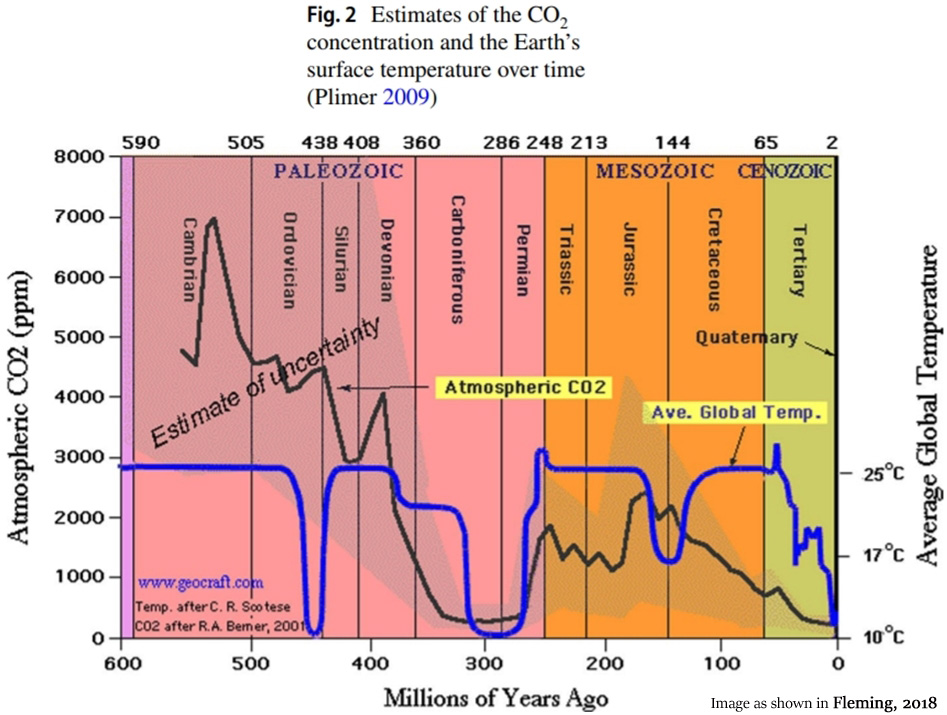
Water Vapor Dominates
“The concentration of CO2 is considered to be uniform over the atmosphere at 400 ppmv. The concentration of water vapor varies from a maximum of 40,000 ppmv (Hong Kong) to the lowest measured value of 4 ppmv in the upper stratosphere. A value for water vapor at one km is estimated to be 11,000 ppmv, so the ratio of mass of H2O/CO2 at one km is approximately 11,000/400=27.5. Comparison of the absorption coefficients over the full range of 1.5–18 µm gave the result: CO2/H2O=~5.5. Thus, water vapor dominates by the ratio of 27.5/5.5=5. … The volume of H2O at the one km level alone is capable of absorbing all the available solar heat at the surface, and does absorb five times that of CO2. All the heat adsorbed at the surface was fully redistributed vertically by all the molecules with the help of all the coefficients.”
CO2 ‘No Impact’, ‘Zero Net Effect’ On Temperature
“One can summarize these calculations as follows: whatever the “climate-change regime,” whatever surface heat from the Sun on any given day within that regime, that heat is fully absorbed and fully vertically redistributed throughout the troposphere—there is no propensity for CO2 to store heat in a systematic way over time to produce a climate change effect (as defined in the introduction).”
“Why does the integrated effect of CO2 have so little effect on the total temperature profile? The reason is that the Planck function change with height (temperature) is very strong in reducing the intensity of those relatively few lines with large absorption coefficients. Another reason is that the longwave radiation is diffuse which depletes the intensity rapidly over distance. The diffuse nature of the radiation also leads to the fact that the net radiation for a given level (that sent upward at the bottom of a layer, minus that sent downward at the top of a layer) further reduces the adsorbed CO2 radiation intensity.”
“Other so-called “greenhouse gases” (some with larger absorption coefcients, but all with signifcantly less concentration) have their intensity quickly transferred upward and depleted by the same strong Planck function intensity change that applies to CO2 and H2O. From the historical record and from these calculations one sees that the CO2 concentration had no impact on temperature. It contributes low-level heating and allows upper level cooling for a zero net effect.”
It’s Solar/Cosmic Ray/Cloud Cover Changes
Solar Minimum, Maximum Periods And Climate
“A significant improvement in determining which Grand Minima are important for climate change came with the work of Sharpe (2008) using Jet Propulsion Laboratory DE405 ephemeris data providing the results in Figs. 10 and 11. His C-14 data from Stuiver et al. (1998). The results confirm the reason for the Medieval Warming and the Little Ice Age (1300–1850) with its three separate Grand Minima (Spörer Maunder, and Dalton).”
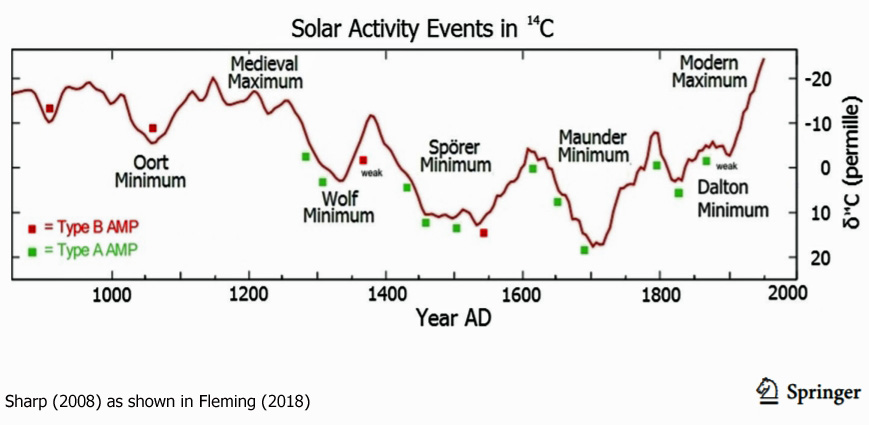
“Since the Little Ice Age, a strong Sun is revealed by both Be-10 and C-14 decreases. The total magnetic flux leaving the Sun (dragged out by the solar wind) has risen by a factor of 2.3 since 1901 (Lockwood et al. 1999). The strong solar magnetic field has shielded the Earth from cosmic rays and is the cause of the Modern Warming that has occurred through to the current time.”
Planetary Positions Determine Solar Grand Minima
“The synodic period (TS—two successive conjunctions of the same bodies) of two planets 1 and 2 is given by 1/TS=1/T1−1/T2 (with T1<T2). The sidereal periods for Uranus and Neptune are 84.02 and 164.79 years, respectively. This gives TUN =172 years. This is the main driver seen in the angular momentum of the Sun about the SSB. The relationship of when a solar Grand Minima occurs always involves these four giant planets in their relationship with the Sun and as depicted in Fig. 11—Uranus, Neptune and Jupiter together and Saturn opposite the Sun.”
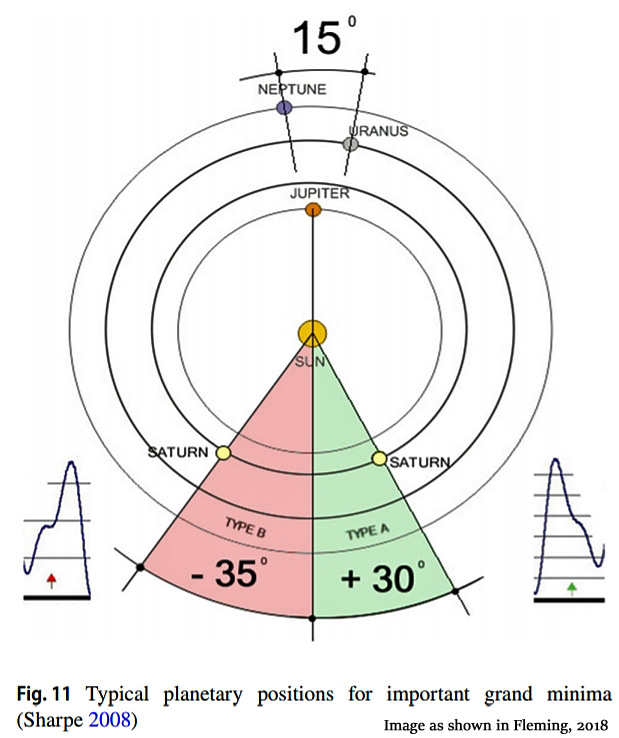
Solar Cycle Length And Temperature
“The sunspot cycle has an average period of 11.2 years, but the length varies from 8 to 14 years. The length of a sunspot cycle (LSC) is an indicator of the Sun’s eruptional activity. The Gleissberg (1965) cycle resulted from his smoothing of the time series of the length of the sunspot cycles (LSC) and a secular cycle of 80–90 years emerged.”
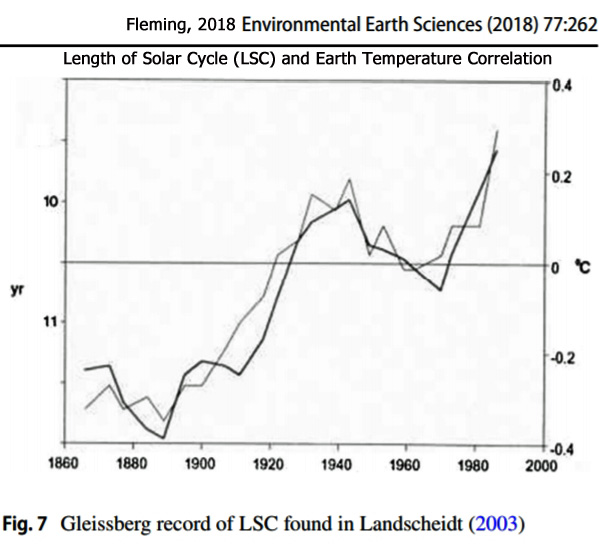
“Figure 7 is from Landscheidt (2003) where Gleissberg’s smoothed data were displayed. The heavy line is the smoothed LSC line and the light line is the land air temperature in the Northern Hemisphere. The heavy line agrees very well with the temperature and also with the temperature record […] with the cooling from 1940 to 1975. It appears that the atmospheric temperature is oblivious to CO2 concentration.”
“The range of the Sun’s orbital angular momentum about the SSB varies from near zero to only 25% of the Sun’s differential angular momentum driving the solar dynamo (Landscheidt 2003). Thus, the strength of the solar dynamo can outweigh the effect of the Sun/planet positions. Nevertheless, these results over this long period strongly suggest that the solar magnetic feld/cosmic ray interaction is the primary cause of major climate-change events over the past 9400 years of the interglacial period. The 35-year cool period within the current Modern Warming was an example where the Gleissberg cycle imposed only a modest impact on the existing strength of the magnetic feld that was in place. The current Modern Warming will continue until the strength of the Sun’s magnetic field declines.”
